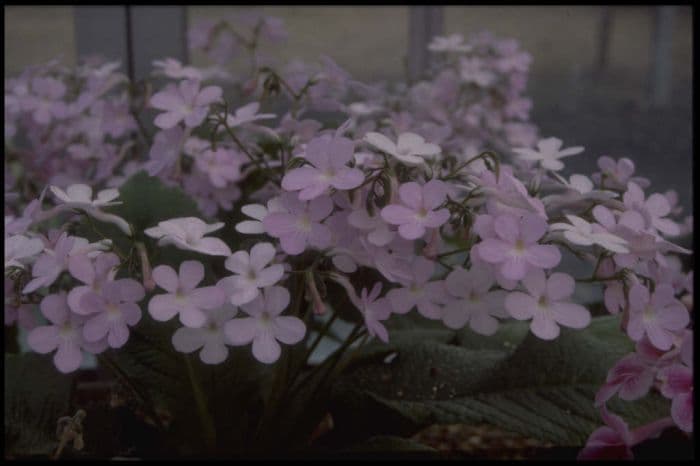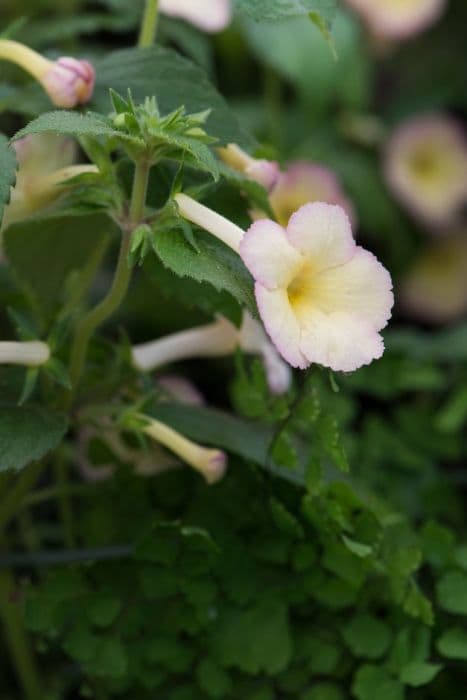Cape Primrose Streptocarpus 'Gloria'

ABOUT
Streptocarpus 'Gloria', often known as Cape Primrose, is a charming flowering plant with a distinctive appearance. It has lush, velvety leaves that are long and narrow, often with a deep green color that can sometimes have a slightly wrinkled texture, providing a delightful backdrop to its blooms. The flowers are the showstoppers of this plant, blossoming in abundance with trumpet-shaped elegance. They exhibit a range of vivid colors, frequently showcasing captivating shades of purples, blues, pinks, or whites, and can have intricate throat markings or patterns that add to their ornamental value. The blossoms are borne on slender stems that elegantly rise above the foliage, creating a striking contrast that makes them stand out in any indoor garden or as part of a decorative arrangement. The overall form of Cape Primrose is one of delicate harmony, with a lush, full appearance that exudes a sense of softness and grace.
About this plant
 Names
NamesFamily
Gesneriaceae
Synonyms
Cape Primrose, African Violet, Twisted Seed Plant
Common names
Streptocarpus 'Gloria'.
 Toxicity
ToxicityTo humans
Cape primrose 'Gloria' is generally considered non-toxic to humans. Ingesting parts of the plant is unlikely to cause poisoning. However, as with any non-food plant, it is possible for individuals to have a sensitivity or allergic reaction to it. Always exercise caution and keep plants out of reach of small children who might inadvertently ingest plant material.
To pets
Cape primrose 'Gloria' is not known to be toxic to pets. It is generally considered safe for cats and dogs if they happen to ingest small amounts. However, it's always best to prevent your pets from eating plants, as individual animals might have different sensitivities or could experience gastrointestinal discomfort, vomiting, or diarrhea from ingesting non-food items.
 Characteristics
CharacteristicsLife cycle
Perennials
Foliage type
Evergreen
Color of leaves
Green
Flower color
Varies
Height
1 foot (30 cm)
Spread
1 foot (30 cm)
Plant type
Herb
Hardiness zones
10
Native area
Africa
Benefits
 General Benefits
General Benefits- Easy to care for: Streptocarpus 'Gloria', commonly known as Cape Primrose, is a low-maintenance plant that thrives with minimal care.
- Long blooming period: Cape Primrose often has a long flowering season, adding color to an indoor space for extended periods.
- Brightens up indoor spaces: With its vibrant flowers and attractive foliage, Cape Primrose can enhance the aesthetics of any room.
- Variety of colors: The flowers of Cape Primrose come in various shades, offering a range of color options for home decor preferences.
- Compact size: Being a compact plant, it is ideal for windowsills, desks, or small spaces.
- Propagation: Cape Primrose is relatively easy to propagate from leaf cuttings, allowing gardeners to expand their collection or share with friends.
 Medical Properties
Medical PropertiesThis plant is not used for medical purposes.
 Air-purifying Qualities
Air-purifying QualitiesThis plant is not specifically known for air purifying qualities.
 Other Uses
Other Uses- Education and Science: The Cape Primrose can be used in classrooms or educational programs to teach principles of botany, including plant anatomy, physiology, and the process of hybridization.
- Photography Subjects: With their vibrant colors and attractive patterns, these plants can serve as excellent subjects for photographers practicing macro photography.
- Artistic Inspiration: Artists may use Cape Primrose as a muse for paintings, drawings, or even textile designs owing to their unique blossom shapes and colors.
- Culinary Presentation: Although not edible, the leaves and flowers can be used as non-toxic decorative elements to enhance the presentation of dishes in culinary arts.
- Crafting: Pressed flowers or leaves of the Cape Primrose can be used in creating handmade paper or bookmarks, preserving their beauty in crafts.
- Gift-Giving: A collection of these plants can make a thoughtful living gift that can be more enduring than cut flowers, for occasions such as Mother’s Day or anniversaries.
- Wedding Decor: Potted Cape Primroses or their blooms can be incorporated into wedding decor for table centerpieces or venue decoration.
- Sensory Gardens: These plants can be included in sensory gardens designed for therapeutic purposes, offering visual and tactile stimuli.
- Fragrance Extraction: Although it's not one of the most known uses, if a variety has a notable scent, essential oils could potentially be extracted for use in homemade perfumes or aromatherapy.
- Thematic Landscaping: Cape Primrose can be used in themed garden displays that require specific color schemes, such as fairy gardens or Victorian-style gardens.
Interesting Facts
 Feng Shui
Feng ShuiThe Cape Primrose is not used in Feng Shui practice.
 Zodiac Sign Compitability
Zodiac Sign CompitabilityThe Cape Primrose is not used in astrology practice.
 Plant Symbolism
Plant Symbolism- Persistence: Streptocarpus, also known as Cape Primrose, often symbolizes persistence due to its ability to bloom for several months without a rest period.
- Adaptability: The Cape Primrose is adaptable in its care requirements, symbolizing flexibility and the ability to thrive in varying conditions.
- Hope and Optimism: With its bright and long-lasting flowers, the Cape Primrose is often associated with hope, cheerfulness, and a positive outlook on life.
 Water
WaterCape Primrose should be watered when the top inch of soil feels dry to the touch. This might translate to watering once a week, but always check the soil moisture before watering. It is essential to water the plant thoroughly, allowing excess water to drain out of the pot. Generally, you might use around 8 to 16 ounces of water depending on the size of the pot and the environmental conditions. Be careful not to let the plant sit in water as this can lead to root rot.
 Light
LightCape Primrose thrives in bright, indirect light. The ideal spot for the plant would be near a north or east-facing window where it can receive plenty of light without being exposed to harsh direct sunlight. Avoid placing it in full sun, especially during the hot summer months, to prevent leaf burn.
 Temperature
TemperatureCape Primrose prefers cooler temperatures with ideal conditions ranging from 60 to 75 degrees Fahrenheit. It can survive a minimum temperature of about 50 degrees Fahrenheit and should not be exposed to temperatures above 80 degrees Fahrenheit as this can stress the plant. Keep it away from drafts and sudden temperature changes for best growth.
 Pruning
PruningCape Primrose benefits from pruning to remove spent flowers and encourage bushier growth. Deadhead the old blossoms regularly to promote continuous blooming. Pruning is best done after a flowering cycle completes or when the plant appears leggy. There is no strict schedule for pruning, but monitoring the plant and pruning as needed will ensure it stays attractive and healthy.
 Cleaning
CleaningAs needed
 Soil
SoilCape Primrose requires well-draining soil with high organic matter. A mix of peat moss, perlite, and vermiculite in equal parts works well. The ideal pH for the soil should range from 5.8 to 6.5.
 Repotting
RepottingCape Primroses should be repotted once a year, typically in the spring. They prefer to be slightly root-bound, so don’t choose a pot that is too large.
 Humidity & Misting
Humidity & MistingCape Primroses thrive in moderate to high humidity levels, ideally between 50% and 70%. Avoid environments that are too dry.
 Suitable locations
Suitable locationsIndoor
Provide bright indirect light and keep soil mildly moist.
Outdoor
Plant in shaded area; protect from direct sunlight.
Hardiness zone
10-11 USDA
 Life cycle
Life cycleStreptocarpus 'Gloria', commonly known as Cape Primrose, begins its life cycle as a seed, needing light for germination, which typically occurs within two to three weeks in warm conditions. Once germinated, the seedling grows into a rosette of leaves, during which time it develops a strong root system. As the plant matures, it produces long, slender flower stems bearing tubular flowers of various colors, blooming primarily in spring and summer, with the possibility of year-round flowers in optimal conditions. After pollination, the flowers will fade, and the plant will produce dry, twisted seed pods, which eventually release seeds for the next generation. During its perennial life span, Cape Primrose goes through periods of active growth and dormancy, usually requiring a rest period with less watering in the winter months. Continuous removal of spent flowers and regular feeding during the growing season encourage further blooming and plant vigor.
 Propogation
PropogationPropogation time
Spring to Summer
The Streptocarpus 'Gloria', commonly known as Cape Primrose, can be propagated by leaf cuttings, which is the most popular method for this plant. It is best to undertake leaf cuttings during the growing season, typically from spring to early autumn. To propagate, a healthy, mature leaf is selected and cut across the width into sections, each with a main vein. The cut segments are then placed upright in a moist, well-draining growing medium, ensuring that the soil makes good contact with the cut edge of the leaf. The pot is then placed in a bright location out of direct sunlight and covered with plastic wrap or placed in a propagator to maintain high humidity. It usually takes a few weeks for roots and new shoots to emerge. Rooted cuttings can be potted on into individual pots once they have developed a strong root system.









